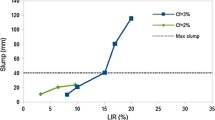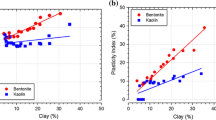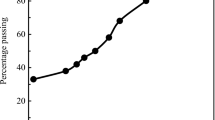Abstract
Surfactants are introduced into the ground either through leakage or a spill, or intentionally for soil remediation. However, their effects on the compressibility and strength characteristics of the ground are largely unknown. This paper examines the effects of reduced surface tension of pore fluid on the liquid and plastic limits, gradation, compressibility, and shear strength of reconstituted clay samples. Clay samples were prepared by mixing kaolin and bentonite with water. The surface tension of the pore fluid was reduced by adding different percentages of a commercial detergent to the pore fluid. The Atterberg limits demonstrated progressively decreasing liquid limits (from 220 to 140) and plasticity indices in clay samples prepared with increasing amounts of surfactant. The SEM images showed a dispersed fabric of face-to-edge and edge-to-edge particle contacts in the original clay soil, while those mixed with surfactant were highly flocculated with clusters of stacked clay particles. Shear strength and compressibility of clay samples were also measured in a series of direct shear and ring shear tests. In the presence of up to 10% detergent, the peak and the residual strengths measured in these experiments increased by about 98–96% and 78–65%, respectively. Nevertheless, the specimens became more brittle with added surfactant during both the direct shear and the ring shear tests. The addition of the detergent to the clay specimens also increased the compression indices from 0.64 to 0.89, as well as the initial void ratio from 2.76 to 2.85.











Similar content being viewed by others
References
Abdul AS, Gibson TL, Ang CC, Smith J, Sobczynski R (1992) In-situ surfactant washing of polychlorinated biphenyls and oils from a contaminated site. Ground Water 30:219–231
Acar YB, Olivieri I, Field D (1984) Organic fluid effects on the structural stability of compacted kaolinite. In Proceedings of the Tenth Annual Research Symposium on Land Disposal of Hazardous Waste. U.S. Environmental Protection Agency, Cincinnati, Ohio. pp 162−171
Ahmad N, Karunaratne G, Chew S, Lee S (2000) Bentonite-kaolinite mix for barrier systems. In: Zimmie TF (ed) GeoDenver 2000: Environmental Geotechnics (GSP 105). American Society of Civil Engineers, Denver, Colorado, United States, pp 93–104
Akbulut S, Nese Z, Arasan S (2012) Surfactant modified clays’ consistency limits and contact angles. Earth Sci Res J 16(2):13–19
Anandarajah A, Zhao D (2000) Triaxial behavior of kaolinite in different pore fluids. J Geotech Geoenviron Eng, ASCE 126:148–155
Anderson DC, Brown KW, Thomas JC (1985) Conductivity of compacted clay soils to water and organic liquids. Waste Manage Res 3:339–349
ASTM (2007) Standard D422: standard test method for particle-size analysis of soils. In Annual Book of ASTM Standards. ASTM International, West Conshohocken, PA
Berney ES, Peters JF, Newman JK, Smith DM (2003) Effect of surfactants on dry-side compaction of silty sand. Transp Res Rec 1819:57–62
Bolt GT (1956) Physicochemical analysis of the compressibility of pure clays. Geotechnique 6(2):86–93
Borghi AD, Binaghi L, Converti A, Borghi MD (2003) Combined treatment of leachate from sanitary landfill and municipal wastewater by activated sludge. Chem Biochem Eng Q 17(4):277–283
Bowders JJ, Daniel DE (1987) Hydraulic conductivity of compacted clay to dilute organic chemicals. J Geotech Eng, ASCE 113(12):1432–1449
Bromhead EN (1979) A simple ring shear apparatus. Ground Eng 12(5):40–44
Brown KW, Anderson DC (1983) Effects of organic solvents on the permeability of clay soils. In Proceedings of the Ninethe Symposium on Land Disposal of Hazardous Waste. U.S. Environmental Protection Agency, Cincinnati, Ohio. p 153
Brown KW, Green JW, Thomas JC (1983) The influence of selected organic liquids on the permeability of clay liners. In Proceedings of the Ninth Annual Research Symposium on Land Disposal of Hazardous Waste. U.S. Environmental Protection Agency, Cincinnati, Ohio. pp 114−125
Brown KW, Thomas JC, Green JW (1986) Field cell verification of the effects of concentrated organic solvents on the conductivity of compacted soils. Hazard Waste Hazard Mater 3(1):1–19
Budhu M, Giese RF, Campbell G, Baumgra L (1991) The permeability of soils with organic fluids. Can Geotech J 28:140–147
Chavez RA (2000) Surfactant impacts on soil properties and feasibility for in-situ remediation of heavy metals. Oklahoma State University, USA
Christensen TH, Kjeldsen P (1989) Basic biochemical processes in landfills. In Christensen TH, Cossu R, Stegmann R (eds) Sanitary Landfilling: Process, Technology and Environmental Impact. Academic Press, London, UK
Chu W, Kwan CY (2003) Remediation of contaminated soil by a solvent/surfactant system. Chemosphere 53:9–15
Chumpitaz LDA, Coutinho LF, Meirelles AJA (1999) Surface tension of fatty acids and triglycerides. J Am Oil Chem Soc (JAOCS) 76(3):379–382
Cui YJ, Yahia-Aissa M, Delage P (2002) A model for the volume change behaviour of heavily compacted swelling clays. Eng Geol 64(2–3):233–250
Douglas DG, MacKay CA (1946) The surface tension of slightly soluble fatty acids. Can J Res 24(1):8–14
Duncan JM, Wright SG (2005) Soil strength and slope stability. John Wiley & Sons, Hoboken, NJ
Eggen T, Moeder M, Arukwe A (2010) Municipal landfill leachates: a significant source for new and emerging pollutants. Sci Total Environ 408(21):5147–5157
Evgin E, Das BM (1992) Mechanical behavior of an oil contaminated sand. Mediterranean Conference on Environmental Geotechnology. A.A. Balkema Publishers, Cesme, Turkey, pp 101–108
Fernandez F, Quigley RM (1985) Hydraulic conductivity of natural clays permeated with simple liquid hydrocarbons. Can Geotech J 22:205–214
Fleureau J-M, Wignyodarsono L, Zerhouni M-I (1988) Effect of surfactants on the mechanical properties of a kaolinite in relation to the solid-liquid contact angles. Can Geotech J 25(4):675–683
Foreman DE, Daniel DE (1986) Permeation of compacted clay with organic chemicals. J Geotech Eng, ASCE 112(7):669–681
Frempong EM, Yanful EK (2008) Interactions between three tropical soils and municipal solid waste landfill leachate. J Geotech Geoenviron Eng, ASCE 134(3):379–396
Gleason MH, Daniel DE, Eykholt GR (1997) Calcium and sodium bentonite for hydraulic containment applications. J Geotech Geoenviron Eng 123(5):438–445
Green WJ, Lee GF, Jones RA (1981) Clay-soils permeability and hazardous waste storage. J Water Pollut Control Fed 53(8):1347–1354
Guha S, Jaffe PR, Peters CA (1998) Solubilization of PAH mixtures by a nonionic surfactant. Environ Sci Technol 32(7):930–935
Hrapovic L (2001) Laboratory study of intrinsic degradation of organic pollutants in compacted clayey soil. The University of Western Ontario, London, Ontario, Department of Civil and Environmental Engineering
Hsuan YG, Koerner RM (1998) Antioxidant depletion lifetime in high density polyethylene geomembranes. J Geotech Geoenviron Eng, ASCE 124(6):532–541
Kamath S, Wulandewi A, Deeth H (2008) Relationship between surface tension, free fatty acid concentration and foaming properties of milk. Food Res Int 41:623–629
Kay D, Blond E, Mlynarek J (2004) Geosynthetic durability: a polymer chemistry issue. In Proceedings of the 57th Canadian Geotechnical Conference, Quebec City, Canada. p 14
Kaya A, Fang H-Y (2011) Experimental evidence of reduction in attractive and repulsive forces between clay particles permeated with organic liquids. Can Geotech J 42(2):632–640
Kjeldsen P, Barlaz MA, Rooker AP, Baun A, Ledin A, Christensen TH (2002) Present and long-term composition of MSW landfill leachate: a review. Crit Rev Environ Sci Technol 32(4):297–336
Lambe TW, Whitman RV (1979) Soil Mechanics. John Wiley & Sons, New York
Lentz RW, Horst WD, Uppot JO (1984) The permeability of clay to acidic and caustic permeants. In: Johnson AI, Frobel RK, Cavalli NJ (eds) Hydruulic Barriers in Soil and Rock, ASTM STP874. American Society of Testing and Materials, Denver, Colorado, pp 127–139
Maisonneuve C, Pierson P, Duquennoi C, Morin A (1997) Accelerated aging tests for geomembranes used in landfills. In 6th International Landfill Symposium. Sardinia, Cagliari, Italy. pp 207−216
Meegoda JN, Vallejo LE, Reddi LN (1996) Engineered contaminated soils and interaction of soil geomembranes. Geotechnical Special Publication (GSP) No. 59. American Society of Civil Engineers (ASCE)
Meegoda NJ (1989) The influence of chemicals on shear strength of clays. In ASTM Symposium on Physio-Chemical Aspects of Soil, Rock and Related Materials, St. Louis, MO
Mitchell JK, Madsen FT (1987) Chemical effects on clay hydraulic conductivity. In Geotechnical Special Publication No. 13. American Society of Civil Engineers, New York. pp 87−116
Moavenian MD, Yasrobi SS (2008) Volume change behavior of compacted clay due to organic liquids as permeant. Appl Clay Sci 39(1–2):60–71
Moore CA, Mitchell JK (1974) Electromagnetic forces and soil strength. Geotechnique 24(4):627–640
Mulder H, Wassink GR, Breure AM, Van Andel JG, Rulkens WH (1998) Effect of nonionic surfactants on naphthalene dissolution and biodegradation. Biotechnol Bioeng 60(4):397–407
Müller W (2007) HDPE geomembranes in geotechnics. Springer-Verlag, Berlin Heidelberg, Germany
Mulligan CN, Yong RN, Gibbs BF (1999) Removal of heavy metals from contaminated soil and sediments using the biosurfactant surfactin. J Soil Contam 8:231–254
Olson RE, Mesri G (1970) Mechanisms controlling the compressibility of clays. J Soil Mech Found Div 96(SM6):1863–1878
Park J, Vipulanandan C, Kim JW, Oh MH (2006) Effects of surfactants and electrolyte solutions on the properties of soil. Environ Geol 49(7):977–989
Ramakrishnan A, Blaney L, Kao J, Tyagi RD, Zhang TC, Surampalli RY (2015) Emerging contaminants in landfill leachate and their sustainable management. Environ Earth Sci 73:1357–1368
Rathfelder KM, Abriola LM, Singletary MA, Pennell KD (2003) Influence of surfactant-facilitated interfacial tension reduction on chlorinated solvent migration in porous media observations and numerical simulation. J Contam Hydrol 64(3–4):227–252
Ratnaweera P, Meegoda JN (2006) Shear strength and stress-strain behavior of contaminated soils. Geotech Test J, ASTM 29(2):133–140
Rowe RK, Rimal S (2008) Aging of HDPE geomembrane in three composite landfill liner configurations. J Geotech Geoenviron Eng 134(7):906–916. https://doi.org/10.1061/(Asce)1090-0241(2008)134:7(906)
Rowe RK, Abdelaal FB, Brachman RWI (2013) Antioxidant depletion of HDPE geomembrane with sand protection layer. Geosynth Int 20(2):73–89
Rowe RK, Abdelaal FB, Islam MZ, Hsuan YG (2010) The strange effect of increasing temperature in accelerated ageing of HDPE GMBs immersed in liquids. In 9th International Conference on Geosynthetics, Guaruja, Brazil. pp 793−798
Rowe RK, Islam MZ, Hsuan YG (2008) Leachate chemical composition effects on OIT depletion in an HDPE geomembrane. Geosynth Int 15(2):136–151
Rowe RK, Rimal S, Sangam HP (2009) Ageing of HDPE geomembrane exposed to air, water and leachate at different temperatures. Geotext Geomembr 27(2):131–151
Sangam HP, Rowe RK (2002) Effects of exposure conditions on the depletion of antioxidants from high-density polyethylene (HDPE) geomembranes. Can Geotech J 39(6):1221–1230
Scheirs J (2009) A guide to polymeric geomembranes: a practical approach. John Wiley & Sons Ltd., West Sussex, UK
Schramm M, Warrick AW, Fuller WH (1986) Permeability of soils to four organic liquids and water. Hazard Waste Hazard Mater 3(1):21–27
Sims RC, Sorensen D, Sims J, McLean J, Mahmood R, Dupont R, Jurinak J, Wagner K (1986) Contaminated surface soils in-place treatment techniques. Noyes Publications, Park Ridge, New Jersey., p 536
Skempton AW (1964) Long-term stability of slopes. Geotechnique 14(2):77–102
Slomczynska B, Slomczynski T (2004) Physio-chemical and toxicological characteristics of leachate from MSW landfills. Pol J Environ Stud 13(6):627–637
Sridharan A, Rao G (1973) Mechanisms controlling volume change of saturated clays and the role of the effective stress concept. Geotechnique 23(3):359–382
Sridharan A, Rao G (1979) Shear strength behavior of saturated clays and the role of the effective stress concept. Geotechnique 29(2):177–193
Tumeo MA (1997) A survey of the causes of surfactant-induced changes in hydraulic conductivity. Ground Water Monit Rem 17(4):138–144
Upot JO, Stephenson RW (1989) Permeability of clays under organic permeants. J Geotech Eng, ASCE 115(115–131):115
Vaution C (1983) Les agents de surface: classification. In Puisieux F, Seiller M (eds) Galenica 5. Lavoisier, Paris, France. pp 5−50
Verwey EJW, Overbeek JTG, van Ness K (1948) Theory of the stability of lyophobic colloids. The interaction of particles having an electric double layer. Elsevier Publishing Company, New York‐Amsterdam. pp 216
Zapata CE, Houston WN, Houston SL, Walsh KD (2000) Soil-water characteristic curve variability. In Shackelford CD, Houston SL, Chang N-Y (eds) Geo-Denver 2000. Denver, Colorado, 5−8 August, 2000. Am Soc Civil Eng pp 84−124
Zhan TLT, Ng WW (2006) Shear strength characteristics of an unsaturated expansive clay. Can Geotech J 43:751–763
Funding
Natural Sciences and Engineering Research Council of Canada-Discovery grant was provided to the author.
Author information
Authors and Affiliations
Corresponding author
Ethics declarations
Consent to participate
Not applicable.
Consent for publication
Not applicable.
Conflict of interest
Not applicable.
Rights and permissions
About this article
Cite this article
Sadrekarimi, A. Effects of surfactant on the consolidation and shear strength of synthetic clay soils. Bull Eng Geol Environ 81, 283 (2022). https://doi.org/10.1007/s10064-022-02786-w
Received:
Accepted:
Published:
DOI: https://doi.org/10.1007/s10064-022-02786-w




